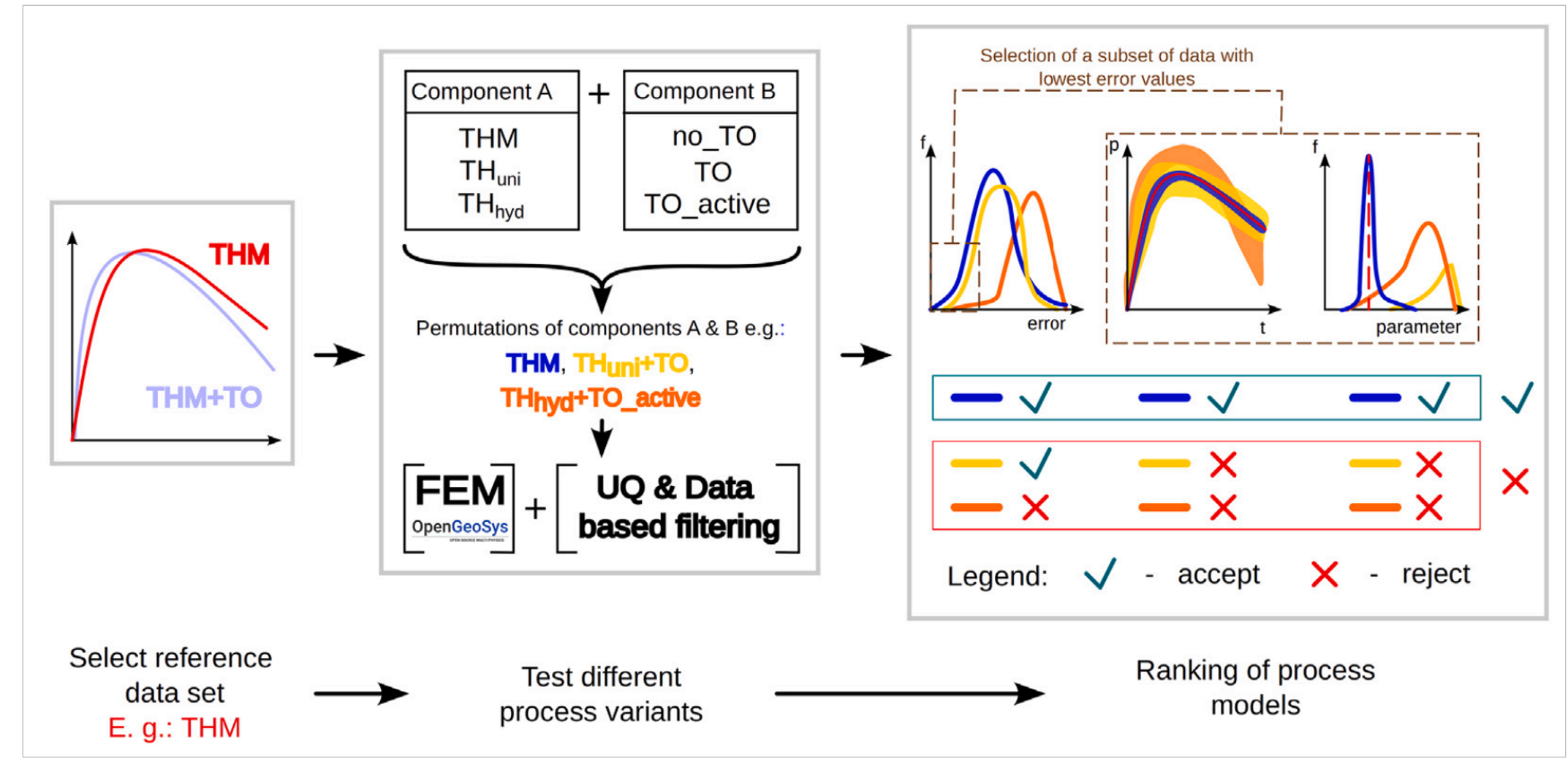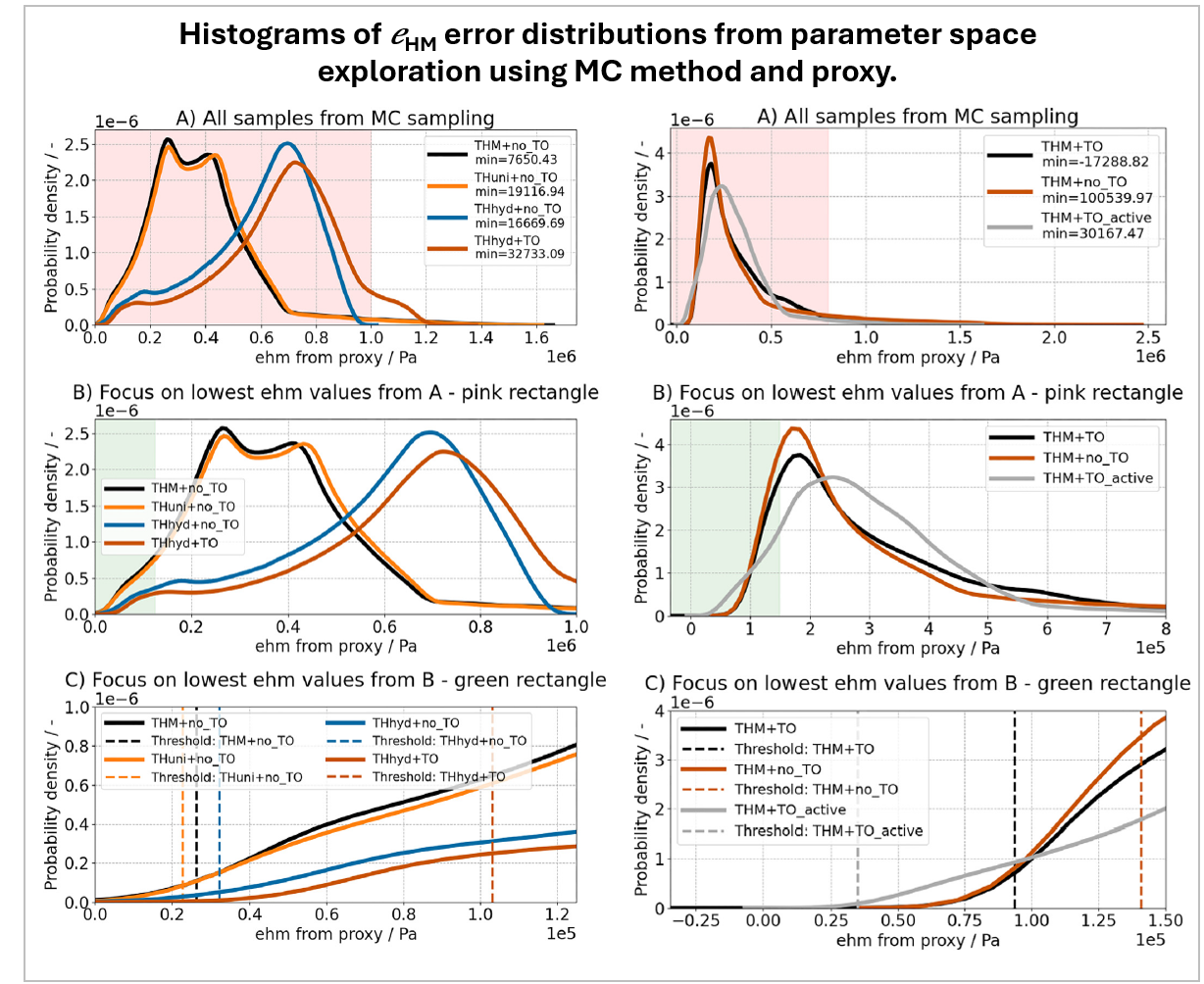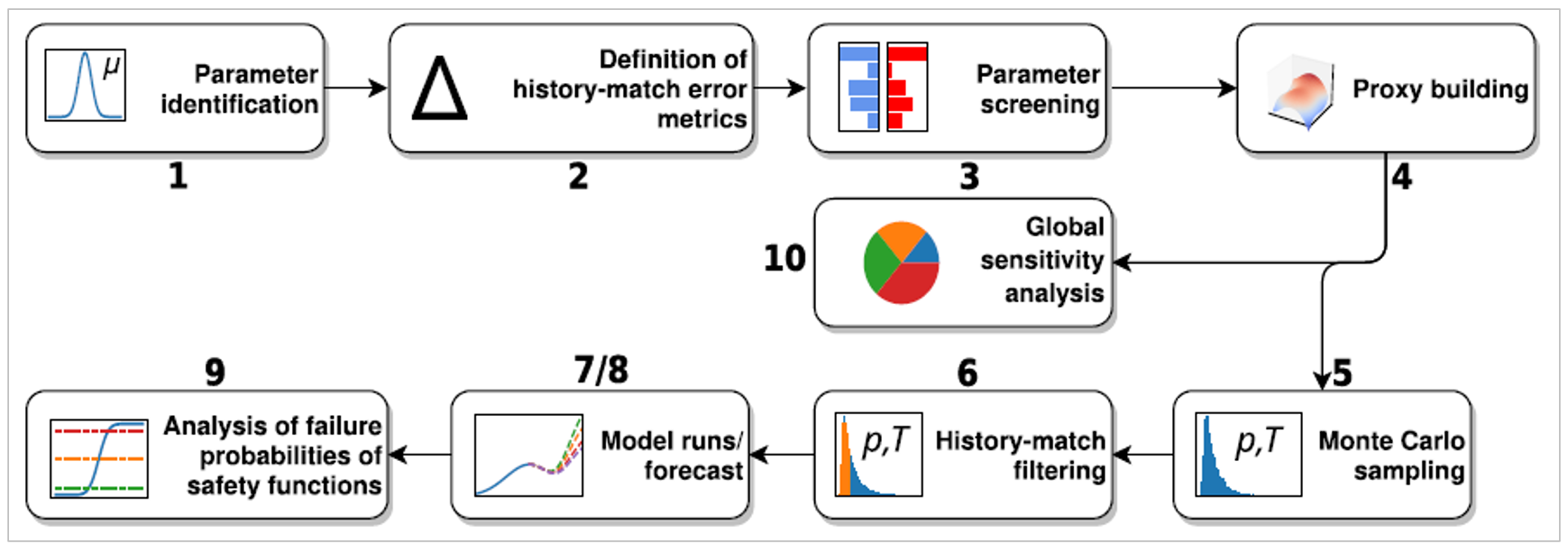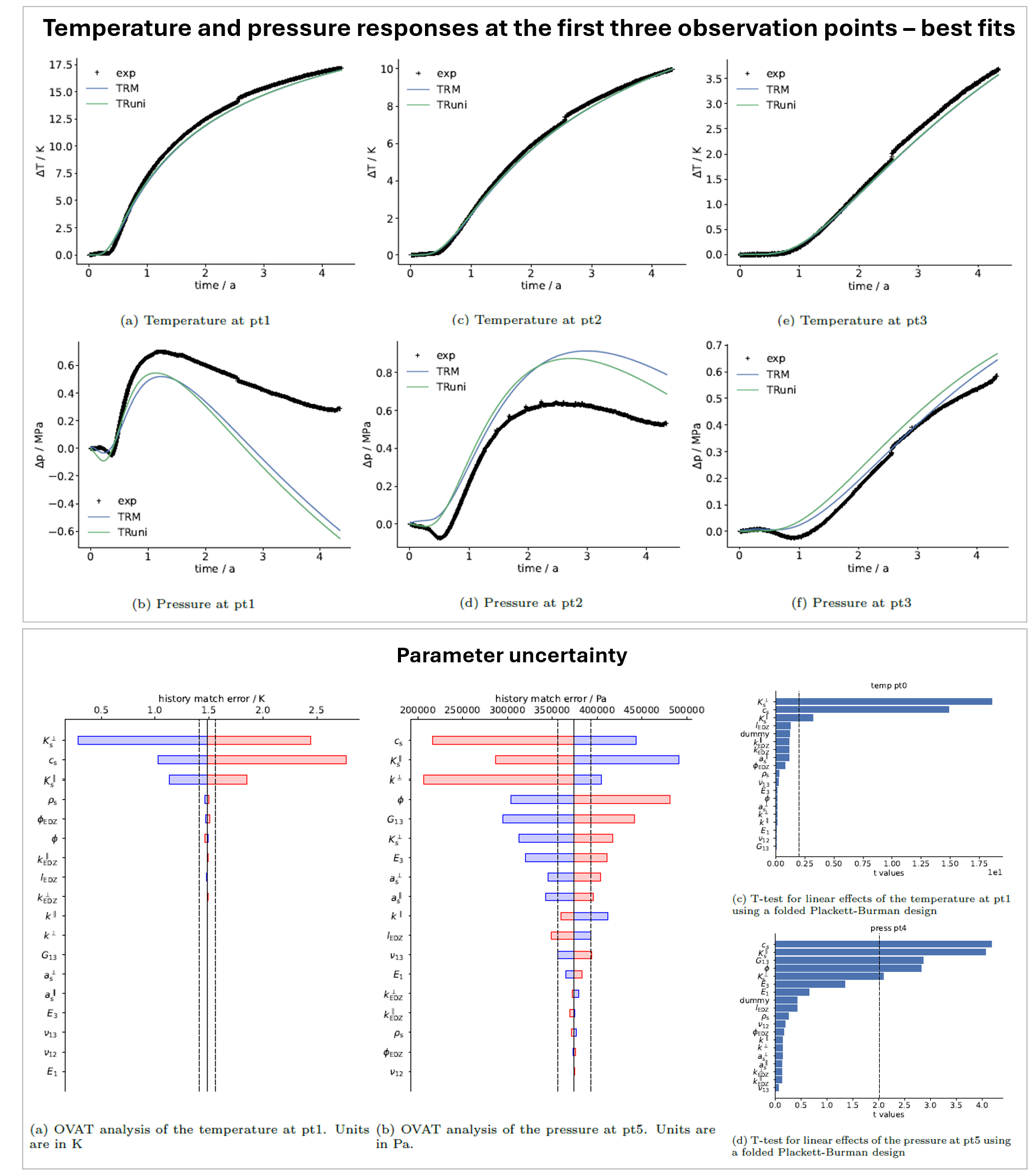¶ Improved characterization (a posteriori distributions) with site-specific information at tunnel-level
¶ Contributors:
- Department of Environmental Informatics (Helmholtz Center for Environmental Research): Jörg Buchwald, Feliks-Kuba Kiszkurno
- Chair of Soil Mechanics (Technical University of Bergakademie Freiberg): Thomas Nagel
¶ Uncertainties introduced by the decision-making process of model design
To ensure long-term safety for the geological disposal of nuclear waste, robust and scientifically justified models are required. For this purpose, we investigate the uncertainties introduced by the decision making in the design of physical (conceptual) models for nuclear waste repository simulations, particularly focusing on the inclusion of thermo-osmosis (TO) in thermo-hydro-mechanical (THM) processes. The research aims to address two primary questions:
- Can thermo-osmosis be exploited as a "tweaking parameter" to artificially improve model fits to observed data without strong physical justification?
- How do process model assumptions and parameter uncertainties interact to influence predictions of thermally induced pore pressure around heat-emitting nuclear waste canisters?

The project uses a synthetic data-based approach to systematically compare THM process models under varying assumptions and parameter ranges. Key steps include:
- Possible process models: THM - A fully coupled model, including thermal, hydraulic, and mechanical interactions, serves as the baseline for physical realism. This is the correct model in this study, as it was used to generate reference data. THhyd and THuni - Simplified models that are evaluated to study the impact of neglecting mechanical effects or assuming uniaxial deformation. They represent slightly (THuni) or completely (THhyd) incorrect conceptual model which will be attempted to be incorrectly overfitted with TO.
- Extension with thermo-osmosis: TO is added to the models as an additional term in the hydraulic flux component. Two parameter ranges for the TO coefficient (wide and narrow) are tested to evaluate its impact and ability to artificially overfit incorrect process models.
- Simulation setup: Simulations mimic a heater experiment inspired by the ATLAS III project, representing heat-emitting waste canisters in clay rock. Five observation points are used to measure pressure responses, focusing on areas with expected strong fluid pressurization.
- Evaluation framework: Assisted History Matching (AHM) is performed using root-mean-square error (RMSE) metrics to evaluate how well simulated pressure curves match reference data. To quantify uncertainties, Latin-Hypercube Sampling (LHS) and Gaussian Process Regression (GPR) are used to explore parameter spaces and identify best-fit models. Finally, models are ranked based on error distributions, parameter ranges, and their ability to produce realistic, physically meaningful results.
In order to evaluate the impact of process model assumptions, parameter uncertainties, and the inclusion of thermo-osmosis (TO) on the prediction of thermally induced pore pressures around heat-emitting nuclear waste canisters, we systematically compare the performance of fully coupled THM models, simplified process models, and their extensions with TO, against synthetic pressure curves generated with a pure THM conceptual model. The evaluation focuses on pressure curve matching, error distributions, and parameter ranges to assess the adequacy of different modeling approaches and to test whether added complexity improves model performance or introduces unwarranted uncertainties.
¶ Key results
Performance of the fully coupled THM model and impact of introducing simplified process models (THuni and THhydr):

The THM model consistently provided the most accurate representation of pressure transients. It demonstrated low history-matching errors, well-constrained parameter distributions, and physically realistic estimates of key properties, such as Young’s modulus and permeability. This is an expected result, since the reference data was generated with it. These findings underscore the importance of selecting correct (physically justified) level of complexity in order to robustly predict pore pressure evolution.
Simplified models, such as THuni and THhyd, exhibited limitations in capturing the observed pressure behavior. THuni, which assumes uniaxial deformation, produced results comparable to the THM model in certain scenarios, validating its use as a reduced-complexity alternative. In contrast, THhyd, which neglects deformation, consistently underestimated pore pressures and produced larger parameter uncertainties, indicating its inadequacy for complex coupled processes.
Effect of Thermo-Osmosis:

Incorporating TO into the process models led to mixed results. When TO was added to the inadequate THhyd model, it appeared to improve pressure curve fits in some cases; however, this often resulted from unrealistic parameter combinations, such as exaggerated TO coefficients or unphysical Young’s modulus values. Wide ranges for the TO coefficient introduced outliers and increased uncertainty, while narrower ranges mitigated these issues but did not resolve the inherent shortcomings of the simplified models.

Uncertainty and parameter sensitivity:
The inclusion of TO in scenarios where it was irrelevant (as per the reference data) highlighted the risk of overfitting through the introduction of additional parameters without physical justification. Incorrect models, such as THhyd with TO, exhibited higher history-match errors and greater uncertainty in parameter distributions. In contrast, correct models (e.g., THM) demonstrated tighter parameter ranges and maintained alignment with known physical properties.
In summary, while the addition of TO can improve model fit under specific conditions, it often increases uncertainty and leads to overfitting when applied without proper justification. The fully coupled THM model remains the most reliable framework, offering accurate predictions and physically meaningful parameter estimates. These findings emphasize the importance of selecting appropriate process models and constraining parameter ranges to ensure robust simulations in the context of nuclear waste repository safety assessments. For further details, the reader is kindly referred to (Kiszkurno et al. 2025).
¶ Design-of-Experiment based history matching
The combination of experimental data, advanced modeling, and sensitivity analysis provides valuable insights into the reliability of THM models leading to our proposed method of design-of-Experiment (DoE) based history matching to give a robust uncertainty quantification framework for repository safety evaluation. The method is illustrated using OpenGeoSys software matching measurement data for a Full-Scale Emplacement experiment at the Mont Terri Underground Research Laboratory as a case study. As part of the research study, we investigate how uncertainty in material parameters and model assumptions impacts predictions of temperature and pressure evolution.

The history matching workflow consists of the following key steps:
- Model setup: The 3D finite-element model simulates heat-emitting waste canisters in Opalinus clay, considering excavation and backfilling effects. Simplified and fully coupled THM models (e.g., TRuni and TRM) are employed to assess the role of mechanical coupling.
- Parameter Screening and Proxy Modeling: Key parameters (e.g., permeability, Young’s modulus, porosity) are screened to identify significant contributors to model outputs. A Gaussian process regression proxy is built to approximate the computationally expensive model response.
- Uncertainty Quantification: A Monte Carlo sampling approach is used to explore the parameter space and evaluate model fit to experimental data. History matching filters are applied to select parameter sets that align with observed temperature and pressure responses.
- Global Sensitivity Analysis: Sobol indices are computed to identify the influence of individual parameters and interactions on model predictions.

The results focus on evaluating the predictive performance of thermo-hydro-mechanical (THM) models under varying assumptions, parameter uncertainties, and levels of mechanical coupling. We draw the following observations:
Model Accuracy:
The fully coupled TRM model provided the most accurate predictions, especially for temperature responses, with near-perfect agreement with experimental data. Simplified models, such as TRuni, showed good performance for temperature but struggled with pressure predictions due to oversimplified mechanical coupling.
Parameter Insights:
Key parameters, such as thermal conductivity and permeability, were identified as critical for temperature and pressure evolution. However, discrepancies in pressure predictions highlighted potential model gaps, such as neglected thermo-osmosis effects.
Uncertainty Reduction:
The DoE-based history matching successfully narrowed parameter ranges, demonstrating the effectiveness of the approach in reducing uncertainty. However, remaining gaps in pressure predictions suggest the need for further refinement of physical models.
Further details about the study results can be found in (Buchwald et al., 2024).
¶ References
- F. Kiszkurno, J. Buchwald, C. B. Silberman, O. Kolditz, T. Nagel (2025): Is more always better? Study on uncertainties introduced by decision-making process of model design - A case study with thermo-osmosis. International Journal of Rock Mechanics and Mining Sciences, 189. DOI:10.1016/j.ijrmms.2025.106075
- J. Buchwald, O. Kolditz, T. Nagel (2024): Design-of-Experiment (DoE) based history matching for probabilistic integrity analysis - A case study of the FE-experiment at Mont Terri. Reliability Engineering and System Safety, 244. DOI:10.1016/j.ress.2023.109903